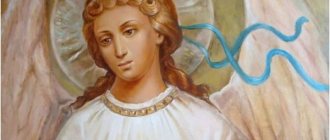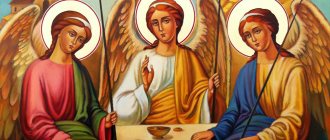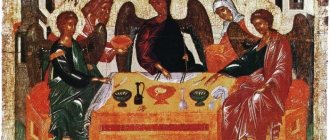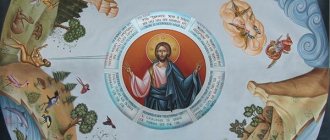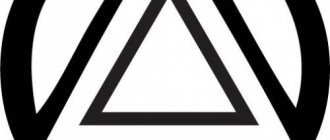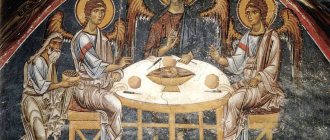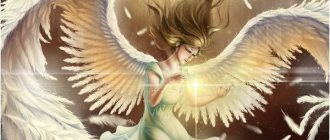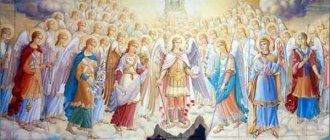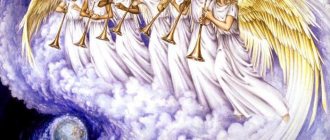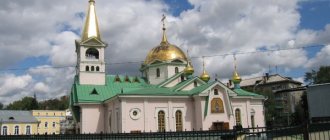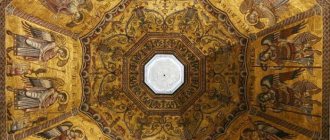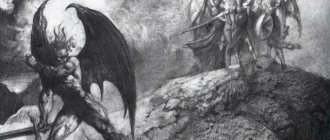Trinity Old Testament
The icon depicts three angels, in the image of each of which there are features and details that make it possible to determine who personifies all three hypostases. This is canonical iconography and the basis for this particular image was the Old Testament story about the hospitality of the forefather Abraham, which is described in the book of Genesis. As it is said, angels appeared to Abraham as he sat near his tent. Seeing the travelers, he offered them rest and a meal in his tent, without demanding anything in return. It was the episode of the meal of the three angels in the Mamvrian oak grove that was captured by icon painters.
The first such images appeared in the catacombs of the first Christians, and already in them one can find that the angels are deliberately similar to each other, which is manifested by the same appearance, poses and clothing. Over time, the iconography becomes more symbolic, angels are no longer depicted as travelers, but become a symbol of the trinity of the Divine - unmerged and inseparable. Gradually, hypostatic attributes are added to the iconography: for example, a cross-shaped halo on one of the angels, symbolizing Christ. However, the hypostases were not always highlighted.
It is believed that the pinnacle of artistic and, in many ways, theological perfection is the famous “Life-Giving Trinity” by Andrei Rublev. The ideal composition of the figures inscribed in a circle is complemented by the individuality of each of them: despite the fact that the hypostases are not clearly identified, by indirect signs it is possible to determine which of the angels is the personification of one or another hypostasis of the Trinity. So, for example, by the clothes of the middle angel you can understand that it is he who personifies Christ. On his right shoulder you can see a special gold patch - a clav, symbolizing royalty (this is a detail of the clothing of the emperors of Byzantium). Also, the colors of the clothes of the middle angel - blue and red - are characteristic of the iconography of Christ, and symbolize the Divine (heaven) and human (blood) natures combined in Him. It was Rublev’s Trinity that became a canonical example of iconography and an example to follow in the future.
Icon of the Holy Trinity by Andrei Rublev and Fyodor Ushakov
The holy face plays a very important role for Christian believers, because this icon shows all of humanity what a strong connection can be when you really sincerely believe in it.
This icon is found only in Orthodoxy. It depicts the three Holy Spirits, who are represented as three travelers who met Abraham. This image was painted with one purpose, so that any Christian could clearly see Orthodoxy, which contains the three-solar world. Christian believers, looking at this icon, will be able to understand all the efforts and power of the Lord. After reading this article you will become familiar with: The meaning of the image, in what cases prayers are offered to it, in which churches it is kept, and so on.
Dear Brothers and Sisters, we will be very glad if you subscribe to our VKontakte group, there you will find even more prayers, icons and other interesting information, here is the address link - Orthodox group!
New Testament Trinity
In addition to the canonical image of the “Old Testament Trinity,” there is also a tradition of depicting the “New Testament Trinity.” From a theological and canonical point of view, these images are very controversial, since, firstly, they share the single essence of the Trinity, and secondly, they depict God the Father. According to the words of the Apostle John: “No one has ever seen God; The only begotten Son, who is in the bosom of the Father, He has revealed.” (John 1:18) The iconography of God the Father in the form of an old man goes back to the text of the book of the Prophet Daniel: “... behold, with the clouds of heaven came one like the Son of man, came to the Ancient of Days and was brought to Him. And to Him was given dominion, glory, and a kingdom, that all nations, nations, and languages should serve Him” (Dan. 7:3-14). However, theologians have always been against such images and attempts have been made repeatedly to ban such iconography as heretical. The Moscow Council, held in the 17th century, decided that “Lords of Hosts” should not be written, because “only Christ was seen in the flesh, as he is painted, that is, depicted according to the flesh, and not according to the Divinity.” That is, anthropomorphism in the depiction of God the Father (and at the same time the Holy Spirit) was rejected.
But there is a version that on many icons of the “New Testament Trinity” it is not the hypostasis of God the Father that is depicted, but Christ - but in the form of the very “ancient of days,” according to the prophet Daniel, who will reign forever, that is, after the Last Judgment. Indeed, on one of the icons, called “Fatherland,” God the Father is depicted on the throne, and on His knees is Christ Emmanuel (the Child), holding in his hands a sphere with the image of a dove, symbolizing the Holy Spirit. Both the Father and the Son on this icon have cross-shaped halos, and the clave is written on their clothes - attributes characteristic only of the image of the Savior. In addition, there are images of Christ, where He is depicted precisely as an old man (for example, the now lost fresco “Christ the Ancient of Days,” in the Church of the Transfiguration on Nereditsa of the 12th century, Greek miniatures of the 13th century). The basis for such a controversial depiction of the Trinity is precisely the words of the Gospel that the Son revealed the Father, and therefore He must be depicted as the incarnation of the Holy Trinity. By the way, among the images of the “Old Testament Trinity” you can also find icons where all three angels are signed “IC. HS,” illustrating the same idea that it was Christ who revealed God to us. And therefore, only such iconography - that is, the “Old Testament Trinity” - seems to be the most correct from a dogmatic point of view. The images of the “New Testament Trinity” are considered non-canonical in the Orthodox Church.
Simon Ushakov repeatedly addressed the theme of the Old Testament Trinity, but only one large icon of his work with such an image has survived to our time. He wrote the second monumental work on this topic in 1677 together with Nikita Pavlovets (MGOMZ).
The image of the Old Testament Trinity embodies the fundamental dogma of the Christian religion, according to which God is one in three Persons - the Father, the Son and the Holy Spirit.
The Old Testament tells how God appeared to the hundred-year-old righteous old man, forefather Abraham, in the form of three wandering angels. Abraham and Sarah treat travelers under the oak of Mamre. Angels predict the birth of their son Isaac.
The artist sought to get rid of the conventional canons of icon painting, to achieve three-dimensionality, physicality of figures and faces. The perspective construction of the composition is reminiscent of the architectural backgrounds of Renaissance paintings. Here the shapes of the “chambers” are reminiscent of the paintings of P. Veronese, and the iconography goes back to Rublev’s “Trinity”. However, this work does not carry the high spirituality that was inherent in the creations of Andrei Rublev. The angels here look like completely living creatures, and the table with a cup - a symbol of the sacrament of the sacrifice of atonement - has turned into an ordinary still life.
A unique feature of the icon is the depiction of the chambers of orders. The question of their iconographic source was partly resolved by N.P. Sychev, who indicated architectural fantasies in Paolo Veronese’s painting “The Feast of Levi the Publican” (Accademia Gallery, Venice) as their indirect prototype. The city view on the right side of the canvas is connected with the portico on the icon of the Russian Museum through intermediate iconographic links. Probably among them was an engraving from Merian's illustrated Bible, in which a similar “veduta” is visible on a sheet with the prophet and King David playing the harp in the background.
The color of the icon harmoniously combines white, red and beige, brownish-green and dark green, gold and silver, enriched with lilac and red varnish. Pink and purple play an important role, used in painting the robes and wings of angels. The wings themselves make an unusual impression due to the “life-like” interpretation of the feathers with the shaft and barbs painted in gold or silver, as well as the absence of subferns. This image of wings can be found in other works of Simon Ushakov, for example on the Royal Doors of 1672 from the cathedral church of the Chudov Monastery (Moscow Kremlin Museums). Along with the white chambers visible in the archway and the white tablecloth, the brightest spots in the composition are the faces framed by lush soft curls. Thin pink ribbons are woven into the angels' hair. The eyes and lips of the heavenly messengers are painted in the recognizable Ushakov style. Due to multi-layered writing, Simon Ushakov achieved the impression of three-dimensionality of shape and relief of volume. Moreover, each angel is given an individual appearance.
P. V. Zapadalova // Autumn of the Russian Middle Ages. St. Petersburg 2022. P. 72.
It remains unknown for which temple the icon was intended, but we know the name of its customer. It has been established that Nikolai Nicoletta was a Greek, a native of the city of Ioannina, who came to Moscow “with paid Russian polonyaniki” and all sorts of goods, and in 1679 he permanently moved to the capital of the Muscovite kingdom.
At the lower border of the centerpiece in the center there is an inscription in white: [In the year from Adam 7180, from the Nativity of Christ 1671, October 16, by the zeal of the royal master named Pimen Fedorov, nicknamed Simon Ushakov, in the city of Moscow. With the care and expense of Nikolai Evstafiev Nikoleta] (translated by B. L. Fonkich). The second inscription in Russian: “For the repose of schema monk Filaret, schema monk Savvaty, schema monk Sergia.”
Discovered in 1926–1927 at the State Russian Museum by I. Ya. Chelnokov, in 1936 by Ya. V. Sosin.
Show full text Hide full text
| Similar cloud marks with the composition “Old Testament Trinity”, the entire background of which is covered with golden horizontal strokes, are found in the upper part of Simon Ushakov’s icons “St. Macarius of Unzhensk” (1661, NGIAMZ) and “Great Martyr George” (1677, National Museum of Georgia). All four images of the Holy Trinity are united by belonging to a brief summary of iconography: apart from the three angels, no additional characters are presented here. The compositional features of the “Holy Trinity” of 1677 and a similar image by Ilya Filippov of 1673 (?) (PGHG) allow us to speak about the conscious appeal of the masters of the Armory to the iconography of the revered and attributed to Andrei Rublev icon from the Trinity Cathedral of the Trinity-Sergius Monastery. They do not coincide with it in size, but the similarity of the compositions - the mutual relationship of the poses and gestures of the three angels, the general design of the contours of their clothes, wings and staffs, the shape of the chamber in the background, the outlines of the table, footstools and seats, the presence of only one bowl on the table - confirms the correctness of this assumption. In comparison with the icons of 1673 (?) and 1677, the image in question is less similar to the famous protograph. |
Prayer to the icon of the Holy Trinity text in Russian
“Life-giving Trinity, the one-essential State, the Creator of all earthly miracles, we thank You for everything that You have sent down to sinners and despised us so far, we live in the world with faith, for everything that You give to each of us every single day, and for the fact that prepared for a bright future for everyone! For such blessings, for all miracles and values, we thank You not only in words, but also in deeds, who keep and fulfill Your covenants: we, however, will reject the Christian teaching from the countless sins and iniquities of those who lived in our youth. And for the sake of this, so that unworthy and sinners do not appear shamelessly before Your Most Holy Image, but do not desecrate Your Most Holy Name, which has prevailed over us, and even as You Yourself deigned, to our happiness, to announce how the pure and righteous are merciful, and the unworthy You have mercy on those who repent and accept them favorably. Hear, O Mighty and Holy Trinity, from your Holy Kingdom of Heaven us, unworthy, and accept our pious prayer, instead of good deeds; and send us a feeling of true repentance, and hating any sinful act, in truth and in faith, until the end of our worldly life, fulfilling Your holy command and glorifying Your most holy and magnificent name with good thoughts and good deeds. Amen."
Days of veneration and dates of holiday icons
Honoring in memory of the three Divine pilgrims (angels) occurs on the fiftieth day of the Ascension of Jesus Christ, and in Orthodoxy it is called “Pentecost”, an event that took place over twenty centuries ago. It was then, fifty days after the Resurrection of Christ, that the Holy Spirit appeared to the Apostles. And then the New Testament was created, which over time influenced the formation of the Christian faith.
How does the Holy Trinity icon help?
• Prayers read before the icon can help a Christian believer find the true path, cope with various life obstacles, and much more; • the icon of the Holy Trinity will also help you see the much-needed light of faith, and will calm down unnecessary worries; • For believers who sincerely believe the miraculous face will help in solving various issues; • Among other things, near this icon you can receive forgiveness of sin or cleansing from negative energy, but only on the condition that the person asking will pray from a pure heart and with sincere faith.
Miracles icons
The divine image has been known since ancient times for its miraculous influence, which has historical confirmation, one of which is associated with the Russian ruler Ivan the Terrible:
On the eve of his departure to war with the Kazan kingdom, Ivan the Terrible went to the miraculous face, which was located in the Trinity-Sergius Lavra. From the surviving evidence, it became known that Ivan the Terrible asked for a very long time and sincerely in prayer before the icon for the granting of protection and blessing for victory in a military campaign.
In that campaign, Ivan the Terrible actually won a victory, and when he returned home, the king again headed to the Lavra, where he spent a long time offering thanks in prayer to the Almighty for help and protection.
